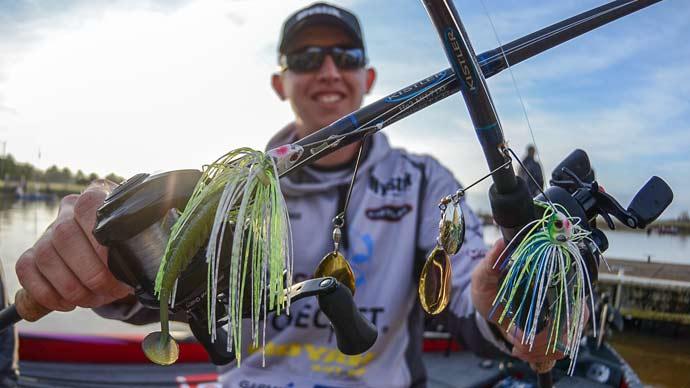
The first Chatterbait came onto the bass world in 2004, March 10 to be exact. When I first saw the Chatterbait in a test tank while walking around ICAST in 2004, I was not that impressed with what I saw. How wrong was I on that read? It only took a few months before this bait took the bass world by storm. When tournaments started to happen in 2005, this was the dominating bait that won the first tournaments of the year, which started the reputation the Chatterbait has grown into today.
The Chatterbait quickly became a bass staple that everybody carries and fishes, just like the spinnerbait and plastic worm, to name a few bass fishing must-haves. Many companies started to jump on board and created their version of the Chatterbait under different names. So going further in this article, I will use the general name of vibrating jig in reference.
Even though the vibrating jig is a blade bait in makeup, it's different from a spinnerbait. But often, it's put in the same category as they are fished in and through the same cover early and late in the season. If you want to compare the vibrating jig to a bait, I would have to go with a square bill. Both baits have the same built-in back-and-forth action, except the vibrating jig is more weedless than a square bill because it's not equipped with open treble hooks.
Blade Make Up Is Key
Central to the vibrating jig is the blade. Different companies have changed this blade configuration to change the action or makeup of their vibrating jig baits. Some of this change is driven by patent infringement, while others have just produced different blade styles that have worked and catch bass along the way.
Lure Parts Online is one that I'll point out. Many of the vibrating jigs I use I build myself using parts from LPO. They have a full selection of blades and parts to pick from to fill all your vibrating jig needs. They also have blades that you can't get on the bass market.
One thing that sets LPO apart from others is blade configurations. They have a blade called Jig Dancer that has holes in the blade. These blades offer a bubble trail that you're not getting from other manufactured vibrating jigs on the market. They also have a Designer Jig Dancer Blades lineup. These blades come painted in crawfish colors (to mimic craw color changes throughout the season), frog, and favorite jig color patterns.
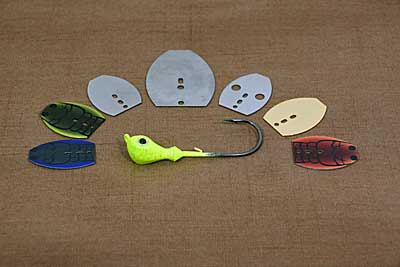
Often it's the little things that will set your vibrating jigs apart from all the others, triggering more bites during your day on the water that will set you apart from the others.
Not only will blade color set your vibrating jig apart from others but blade size will as well. Pay attention to the blade size you're using. Bigger blades will have a different action than smaller blades. In your mix, carry different blade sizes to fill these needs. You carry different blades shapes and sizes for your spinnerbaits. Vibrating jigs blade choices should be no different.
Carry different blade sizes, styles, and colors for your vibrating jigs as well in your mix. If you get three fishermen who go down the bank throwing a 3/8oz silver bladed vibrating jig with a white/chartreuse skirt, the first fisherman who follows them throwing a gold or colored bladed vibrating jig is going to get bites. Changing blades will get you more bites in your days on the water that will pay you valuable dividends overall.
While talking about blades, I would like to bring up one more point, bend your blade, or leave it straight?
If you look at a Chatterbait, the blade is bent back. If you look at other brands, the blade is straight. I mimic the Chatterbait by bending the blade back when I make my baits. My biggest reason for doing this is I feel the blade tracks quicker and better. If I did not bend the blade back, I would give the bait a quick snap with the rod to get the bait tracking right. Getting the blade to grab is the best way to put it. By bending the blade back slightly, I feel the blade grabs quicker and starts to track straight in the first turn of my reel handle.
Jig Heads
If you're making your vibrating jigs, I use two different jig heads, and both are from Lure Parts Online. The primary jig head that I use is the Power Stroke for a few distinct reasons. They come in 3/8oz, 1/2oz, 3/4oz, 1oz sizes, and 12 assorted colors. They also come equipped with a wire trailer keeper.
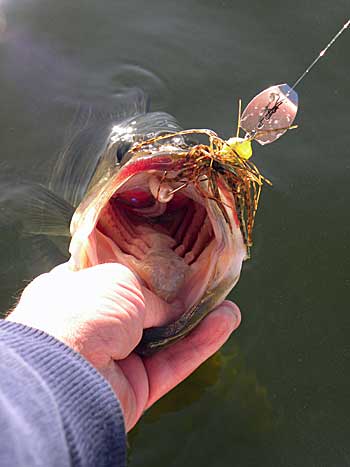
One of my biggest pet peeves when using other vibrating jigs is my trailer won't stay locked in place. After two casts, I spend a few seconds putting my plastic trailer back into place each time. The wire trailer keeper on the Power Stroke jig head keeps my trailer locked in place, and I can concentrate on catching bass, not repositioning my trailer every other cast.
Rig your vibrating jig with a weedless football head jig if you're looking for another option. The reason is these football heads come equipped with weed guards. In some instances, this will allow me to get my bait through thicker weed areas that I may not get a regular vibrating jig through without getting it fouled.
The biggest reason for the jig head change is this vibrating jig will put off more sound. The wider football head will contact the blade motion creating more sound/commotion when fishing. This is different from what other fishermen are using, and I have often been able to go right behind someone who just came through an area and trigger bites.
What turned me onto this was I was fishing early spring with one of these modified baits, and I was in the back of the boat. My fishing partner and I threw vibrating jigs in a shallow spawning area. After we made a pass, I was the only one catching bass. My partner turned to me and said, “what are you throwing”?
So, I told him, “Hold on” I grabbed scissors and cut my bait off and handed it to him, and said, “tie this on.” Then I dug into my box, grabbed a different vibrating jig, and tied it onto the end of my line. As we made another pass back through the same area, he was the one catching all the bass this time. This little on-water experience opened my eyes that I had something with my new setup. The wider football jig head made more contact with the blade creating more sound and commotion during the retrieve.
When I first created this bait, I used a weed guard to create a more weedless presentation, not knowing that I was creating a new vibrating jig variation. To this day, this combo is now in my vibrating jig box and a part of my mix day in and day out.
Skirts And Trailers
When picking skirts and trailers, try to match what you're trying to imitate in your waters. If the number one forage in the body of water is bluegills, start with a bluegill skirt. I would add a swimbait trailer or a chartreuse tail trailer for this setup. If you don't have a chartreuse trailer, you can add a chartreuse color by using a plastics dye, which is to your benefit as you're also adding scent at the same time.
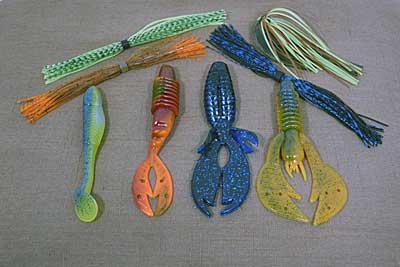
I'll also carry accent-colored skirts to compliment my skirt collection. By adding strands of chartreuse, red, or orange, I have added colors to my skirt that make it stand out a little better in both clear water and stained water conditions. Use these accents to your advantage to add a few more bites during your days on the water.
There will also be times when you will be fishing in dirty water conditions. When it comes to situations like this, there are a few different colored skirts that I turn towards. First up is a straight black and blue skirt combo. Next will be a mix of orange, chartreuse, and white. This skirt stands out better than others that I have used, and I have caught many bass using this skirt through the years.
When picking trailer shapes and colors, use your judgment to try to add a bait trailer that you're trying to imitate. If you're trying to imitate a bluegill or shad, use a swimbait. If you're trying to imitate a crawfish, use a craw. If you're trying to add attractor colors, often, I'll turn to a grub to get the job done.
Also, use your trailer choice as a depth control tool when needed. If you need to keep your bait at a certain depth, then use a bigger, bulkier trailer to help keep your bait higher in the water column. A perfect bait for this tactic is a creature bait. A creature bait has a good flat bottom that will help keep your bait up above the cover when needed.
Vibrating Jig Equipment Setup
For equipment, I keep it simple. I use a 7ft MH Denali Attax rod (AC703F) with a 6.2:1 Lew's baitcasting reel. On this, I'll spool 15lb Sunline Assassin FC. I use this setup for 80% of my vibrating jig fishing. I get good casting distance and excellent hook setting power from this setup. Also, with the 7ft rod, I can make underhand casts to hit shore targets when I need to get my bait to where the bass are holding close to or in the cover.
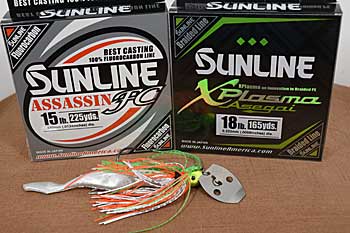
I also carry a Denali Attax 7ft medium baitcaster (AC702f) that I also team with a Lew’s 6.2:1 reel spooled with 18lb -30lb Sunline Asegai braided line. The reason for this is a few distinct reasons.
One, I'll downsize to a 1/4oz to 3/8oz Chatterbait when I need to keep my bait above the cover or when fishing in shallow water during the spawning season. The braid helps keep my bait up in the water column, and its limited line stretch gives me a solid hook set at the end of a long cast.
If I'm targeting deeper water bass, I'll up my rod size to a 7’6” MH rod with a 5.1:1 Lew’s BB-1 baitcaster. Spooled on the reel is 15lb Sunline Assassin FC. Make your cast and let your vibrating jig settle to the bottom. You will know your bait is there as your line will go slack. When that happens, give your rod a quick pull to get your bait up off the bottom, then slowly start to reel. Your goal is to keep your vibrating jig on the bottom. If you're not making contact with the bottom as you're working your bait back to the boat, you're reeling too fast. The strike triggering factor is the bait scooting along the bottom, acting like something (craw or baitfish), trying to get away from the bass. This will often trigger strikes from bass in the area.
I hope these vibrating jig presentation and tactics help you when you're fishing a vibrating jig in your area and help you put more bass in your boat. If you buy your vibrating jigs or make them as I do, you will need to make adjustments to get better action and improved fish-catching power out of these baits, as you do with many others in your tackle box. Taking a closer look at the vibrating jig today, I shake my head when I see what this bait can do and how powerful a bass-catching tool it has turned out to be.
BassResource may receive a portion of revenues if you make a purchase using a link above.



